6.Redis,一站式高性能存储方案
1.Redis入门
- Redis是一款基于键值对的NoSQL数据库,它的值支持多种数据结构:
字符串(strings)、哈希(hashes)、列表(lists)、集合(sets)、有序集合(sorted sets)等。 - Redis将所有的数据都存放在内存中,所以它的读写性能十分惊人。
同时,Redis还可以将内存中的数据以快照或日志的形式保存到硬盘上,以保证数据的安全性。 - Redis典型的应用场景包括:缓存、排行榜、计数器、社交网络、消息队列等。
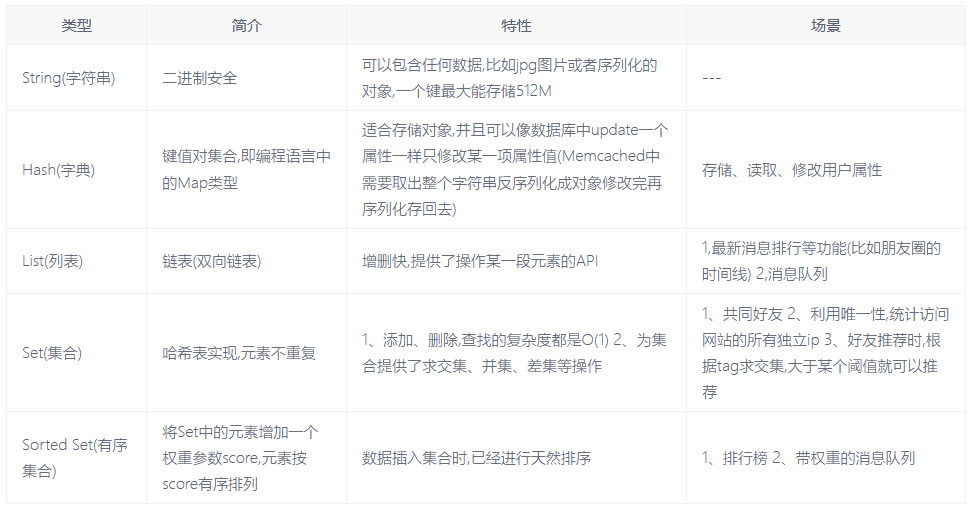
reids默认有16个库,从0-15,可以使用select [index]切换
2.SpringBoot整合Redis
- 引入依赖
-
- spring-boot-starter-data-redis
- 配置Redis
-
- 配置数据库参数
- 编写配置类,构造RedisTemplate
- 访问Redis
-
- redisTemplate.opsForValue() String
- redisTemplate.opsForHash() Hash
- redisTemplate.opsForList() List
- redisTemplate.opsForSet() Set
- redisTemplate.opsForZSet() Zset
(1)引入依赖
<dependency>
<groupId>org.springframework.boot</groupId>
<artifactId>spring-boot-starter-data-redis</artifactId>
<version>1.5.7.RELEASE</version>
</dependency>
(2)配置Redis
application.properties #默认选用几号数据库 spring.redis.database=0 #redis所在ip地址 spring.redis.host=127.0.0.1 #端口号 spring.redis.port=6379 #密码 没有就不写这个选项 spring.redis.password= #redis连接池选项 本次不需要 spring.redis.jedis.pool.max-active=8 spring.redis.jedis.pool.max-wait=-1 spring.redis.jedis.pool.max-idle=10 spring.redis.jedis.pool.min-idle=2 #超时时间 spring.redis.timeout=6000
(3)RedisTemplate配置
在config包下写一个redis配置类,第三方bean通常通过@Configuration @Bean配置
@Configuration public class RedisConfig { public RedisTemplate<String,Object> redisTemplate(RedisConnectionFactory factory){ //此处的factory是由LettuceConnectionConfiguration装配的 感兴趣可以去看看源码 RedisTemplate<String,Object> template=new RedisTemplate<>(); template.setConnectionFactory(factory); //将对象的状态信息转为存储或传输的形式需要序列化。 //因为要进行网络传输 所以需要将其转化为流 //redis还是nosql 其数据类型在Java中没有对应 所以将其序列化 // 设置key的序列化方式 template.setKeySerializer(RedisSerializer.string()); // 设置value的序列化方式 template.setValueSerializer(RedisSerializer.json()); // 设置hash的key的序列化方式 template.setHashKeySerializer(RedisSerializer.string()); // 设置hash的value的序列化方式 template.setHashValueSerializer(RedisSerializer.json()); template.afterPropertiesSet(); return template; } }
在使用Spring-data-redis 中redisTemplate的 increment() 方法对redis中的缓存数据进行自增/自减操作时,出现了一个缓存数据格式错误或超出范围的异常,而数据本身是没有问题的
这是因为redis中默认存储的数据格式是使用JdkSerializationRedisSerializer序列化的,需通过反序列化才能得到正常的字符串然后进行操作,我们需要手动配置StringRedisSerializer来对数据进行序列化,就可以操作了
在redis的spring配置文件中配置
(4)访问Redis进行测试
Redis-server.exe闪退: 很可能是内存不足,可以先关闭几个电脑进程
@RunWith(SpringRunner.class) @SpringBootTest @ContextConfiguration(classes = CommunityApplication.class) public class RedisTests { @Autowired private RedisTemplate redisTemplate; @Test public void testStrings() { String redisKey = "test:count"; redisTemplate.opsForValue().set(redisKey, 1); System.out.println(redisTemplate.opsForValue().get(redisKey)); System.out.println(redisTemplate.opsForValue().increment(redisKey)); System.out.println(redisTemplate.opsForValue().decrement(redisKey)); } @Test public void testHashes() { String redisKey = "test:user"; redisTemplate.opsForHash().put(redisKey, "id", 1); redisTemplate.opsForHash().put(redisKey, "username", "zhangsan"); System.out.println(redisTemplate.opsForHash().get(redisKey, "id")); System.out.println(redisTemplate.opsForHash().get(redisKey, "username")); } @Test public void testLists() { String redisKey = "test:ids"; redisTemplate.opsForList().leftPush(redisKey, 101); redisTemplate.opsForList().leftPush(redisKey, 102); redisTemplate.opsForList().leftPush(redisKey, 103); System.out.println(redisTemplate.opsForList().size(redisKey)); System.out.println(redisTemplate.opsForList().index(redisKey, 0)); System.out.println(redisTemplate.opsForList().range(redisKey, 0, 2)); System.out.println(redisTemplate.opsForList().leftPop(redisKey)); System.out.println(redisTemplate.opsForList().leftPop(redisKey)); System.out.println(redisTemplate.opsForList().leftPop(redisKey)); } @Test public void testSets() { String redisKey = "test:teachers"; redisTemplate.opsForSet().add(redisKey, "刘备", "关羽", "张飞", "诸葛亮", "赵云"); System.out.println(redisTemplate.opsForSet().size(redisKey)); System.out.println(redisTemplate.opsForSet().pop(redisKey));//随机移除并获取指定集合中一个或多个元素 System.out.println(redisTemplate.opsForSet().members(redisKey)); } @Test public void testSortedSets() { String redisKey = "test:students"; redisTemplate.opsForZSet().add(redisKey, "唐僧", 80); redisTemplate.opsForZSet().add(redisKey, "悟空", 90); redisTemplate.opsForZSet().add(redisKey, "八戒", 50); redisTemplate.opsForZSet().add(redisKey, "沙僧", 70); redisTemplate.opsForZSet().add(redisKey, "白龙马", 60); System.out.println(redisTemplate.opsForZSet().zCard(redisKey)); System.out.println(redisTemplate.opsForZSet().score(redisKey, "八戒")); System.out.println(redisTemplate.opsForZSet().reverseRank(redisKey, "八戒"));//从高到低排序 System.out.println(redisTemplate.opsForZSet().reverseRange(redisKey, 0, 2));//从高到低排序 } @Test public void testKeys() { redisTemplate.delete("test:user"); System.out.println(redisTemplate.hasKey("test:user")); redisTemplate.expire("test:students", 10, TimeUnit.SECONDS); } // 批量发送命令,节约网络开销. @Test public void testBoundOperations() { String redisKey = "test:count"; BoundValueOperations operations = redisTemplate.boundValueOps(redisKey); operations.increment(); operations.increment(); operations.increment(); operations.increment(); operations.increment(); System.out.println(operations.get()); } // 编程式事务(常用),对一段程序进行封装 达到效果 @Test public void testTransaction() { Object result = redisTemplate.execute(new SessionCallback() { @Override public Object execute(RedisOperations redisOperations) throws DataAccessException { String redisKey = "text:tx"; // 启用事务 redisOperations.multi(); redisOperations.opsForSet().add(redisKey, "zhangsan"); redisOperations.opsForSet().add(redisKey, "lisi"); redisOperations.opsForSet().add(redisKey, "wangwu"); System.out.println(redisOperations.opsForSet().members(redisKey)); // 提交事务 return redisOperations.exec(); } }); System.out.println(result); } }
3.点赞
点赞之后需要立即刷新页面,推荐用redis做,速度较快
- 点赞
- 支持对帖子、评论点赞。
- 第1次点赞,第2次取消点赞。
- 首页点赞数量
- 统计帖子的点赞数量。
- 详情页点赞数量
- 统计点赞数量。
- 显示点赞状态。
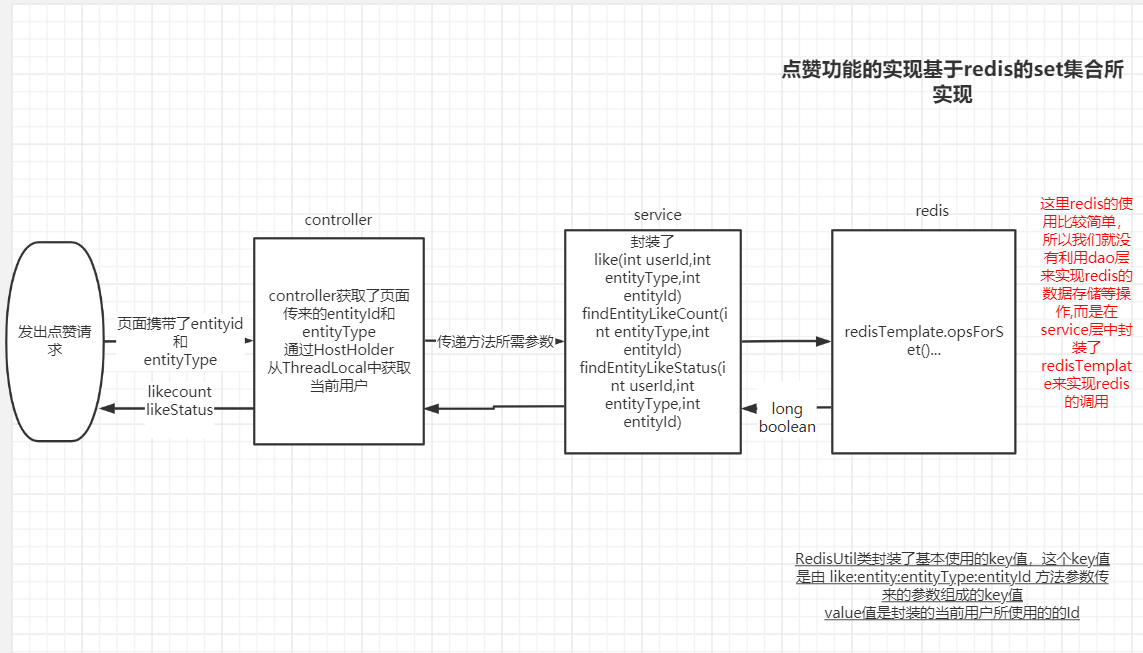
public class RedisKeyUtil { //key的分隔符 private static final String SPLIT = ":"; //点赞的前缀 private static final String PREFIX_ENTITY_LIKE = "like:entity"; // 某个实体的赞 // like:entity:entityType:entityId -> set(userId) public static String getEntityLikeKey(int entityType, int entityId) { return PREFIX_ENTITY_LIKE + SPLIT + entityType + SPLIT + entityId; } }
(1)service层:用redis做点赞功能,不写Dao层
点赞状态:第一次点,redis中没有点赞记录(点赞类型、用户),则添加到redis(点赞),如果有记录,则代表已点赞,这次是点反,则从redis中移除(取消点赞)
@Service public class LikeService { @Autowired private RedisTemplate redisTemplate; //点赞 public void like(int userId,int entityType,int entityId){ //点赞类型(帖子/评论/回复)//实体id(帖子/评论/回复) String entityLikeKey= RedisKeyUtil.getEntityLikeKey(entityType, entityId); boolean isMember=redisTemplate.opsForSet().isMember(entityLikeKey,userId); if(isMember){//第二次点赞:取消点赞 redisTemplate.opsForSet().remove(entityLikeKey,userId); }else{//第一次点赞:添加点赞 redisTemplate.opsForSet().add(entityLikeKey,userId); } } // 查询某实体点赞的数量 public long findEntityLikeCount(int entityType,int entityId){ String entityLikeKey=RedisKeyUtil.getEntityLikeKey(entityType,entityId); return redisTemplate.opsForSet().size(entityLikeKey); } // 查询某人对某实体的点赞状态 public int findEntityLikeStatus(int userId,int entityType,int entityId){ String entityLikeKey=RedisKeyUtil.getEntityLikeKey(entityType,entityId); return redisTemplate.opsForSet().isMember(entityLikeKey,userId)?1:0; } }
(2)controller层
@Controller public class LikeController { @Autowired private LikeService likeService; @Autowired private HostHolder hostHolder; @RequestMapping(path = "/like",method = RequestMethod.POST) @ResponseBody public String like(int entityType,int entityId){ User user=hostHolder.getUser(); //点赞 likeService.like(user.getId(),entityType,entityId); //数量 long likeCount=likeService.findEntityLikeCount(entityType,entityId); //状态 int likeStatus=likeService.findEntityLikeStatus(user.getId(),entityType,entityId); //返回结果 Map<String,Object> map=new HashMap<>(); map.put("likeCount",likeCount); map.put("likeStatus",likeStatus); return CommunityUtil.getJSONString(0,null,map); } }
(3)前端

- href的东西表名跳转的地方是找js的方法
- onclick里的like方法有三个参数
-
- this用来标志是哪里点的赞(帖子可以点赞,用户评论也可以点赞)
- 1表明是给帖子点赞
- post.id是帖子的id号
- 为了方便显示数据把 赞 这个字用< b >标签包围,11用< i >包围

评论点赞:
2表明给帖子评论点赞,其他同理

评论的回复点赞:
3表示给评论回复点赞

添加discuss.js:
function like(btn,entityType,entityId) { $.post( CONTEXT_PATH+"/like", {"entityType":entityType,"entityId":entityId}, function (data) { /*转化成json*/ data = $.parseJSON(data); if(data.code==0){ $(btn).children("i").text(data.likeCount); $(btn).children("b").text(data.likeStatus==1?"已赞":"赞"); }else{ alert(data.msg); } } ); }
(4)controller层:点赞数量显示
首页: 在HomeController中getIndexPage()方法添加代码
//新增:点赞数量 long likeCount=likeService.findEntityLikeCount(ENTITY_TYPE_POST, post.getId());//ENTITY_TYPE_POST:实体类型: 帖子 map.put("likeCount",likeCount);
修改index.html
<div class="text-muted font-size-12"> <u class="mr-3" th:utext="${map.user.username}">寒江雪</u> 发布于 <b th:text="${#dates.format(map.post.createTime,'yyyy-MM-dd HH:mm:ss')}">2019-04-15 15:32:18</b> <ul class="d-inline float-right"> <li class="d-inline ml-2">赞 <span th:text="${map.likeCount}">11</span></li> <li class="d-inline ml-2">|</li> <li class="d-inline ml-2">回帖 <span th:text="${map.post.commentCount}">7</span></li> </ul> </div>
帖子详情:在DiscussPostController中修改帖子、帖子的评论、评论的评论的点赞
@RequestMapping(path = "/detail/{discussPostId}",method = RequestMethod.GET)
public String getDiscussPost(@PathVariable("discussPostId")int discussPostId, Model model, Page page){
//查看这个帖子
DiscussPost discussPost=discussPostService.findDiscussPostById(discussPostId);
model.addAttribute("post",discussPost);
User user=userService.findUserById(discussPost.getUserId());
model.addAttribute("user",user);
//点赞数量
long likeCount=likeService.findEntityLikeCount(ENTITY_TYPE_POST,discussPostId);
model.addAttribute("likeCount",likeCount);
//点赞状态
//先判断是否登录
int likeStatus=hostHolder.getUser()==null?0:likeService.findEntityLikeStatus(hostHolder.getUser().getId(),ENTITY_TYPE_POST,discussPostId);
model.addAttribute("likeStatus",likeStatus);
// 评论分页信息
page.setLimit(5);
page.setPath("/discuss/detail/" + discussPostId);
page.setRows(discussPost.getCommentCount());////帖子相关字段中冗余存了一个commentcount
//帖子的评论:称为--评论 ENTITY_TYPE_POST
//评论的评论:称为--回复 ENTITY_TYPE_COMMENT
// 评论列表
List<Comment> commentList = commentService.findCommentsByEntity(
ENTITY_TYPE_POST, discussPost.getId(), page.getOffset(), page.getLimit());
// 评论显示vo列表
List<Map<String, Object>> commentVoList = new ArrayList<>();
if(commentList != null){
for (Comment comment : commentList) {
//评论Vo :Vo的意思是viewObject的意思 视图对象
Map<String, Object> commentVo = new HashMap<>();
commentVo.put("comment", comment);// 评论
commentVo.put("user", userService.findUserById(comment.getUserId()));// 作者
// 点赞数量
likeCount = likeService.findEntityLikeCount(ENTITY_TYPE_COMMENT, comment.getId());
commentVo.put("likeCount", likeCount);
// 点赞状态
likeStatus = hostHolder.getUser() == null ? 0 :
likeService.findEntityLikeStatus(hostHolder.getUser().getId(), ENTITY_TYPE_COMMENT, comment.getId());
commentVo.put("likeStatus", likeStatus);
// 回复列表
List<Comment> replyList = commentService.findCommentsByEntity(ENTITY_TYPE_COMMENT, comment.getId(), 0, Integer.MAX_VALUE);
// 回复显示vo列表
List<Map<String, Object>> replyVoList = new ArrayList<>();
if (replyList != null) {
for (Comment reply : replyList) {
Map<String, Object> replyVo = new HashMap<>();
replyVo.put("reply", reply);// 回复
replyVo.put("user", userService.findUserById(reply.getUserId()));// 作者
User target = reply.getTargetId() == 0 ? null : userService.findUserById(reply.getTargetId()); // 回复目标
replyVo.put("target", target);
// 点赞数量
likeCount = likeService.findEntityLikeCount(ENTITY_TYPE_COMMENT, reply.getId());
replyVo.put("likeCount", likeCount);
// 点赞状态
likeStatus = hostHolder.getUser() == null ? 0 :
likeService.findEntityLikeStatus(hostHolder.getUser().getId(), ENTITY_TYPE_COMMENT, reply.getId());
replyVo.put("likeStatus", likeStatus);
replyVoList.add(replyVo);
}
}
commentVo.put("replys", replyVoList);
// 回复数量
int replyCount = commentService.findCommentCount(ENTITY_TYPE_COMMENT, comment.getId());
commentVo.put("replyCount", replyCount);
commentVoList.add(commentVo);
}
}
model.addAttribute("comments", commentVoList);
return "/site/discuss-detail";
}
前端前面已经修改过了。

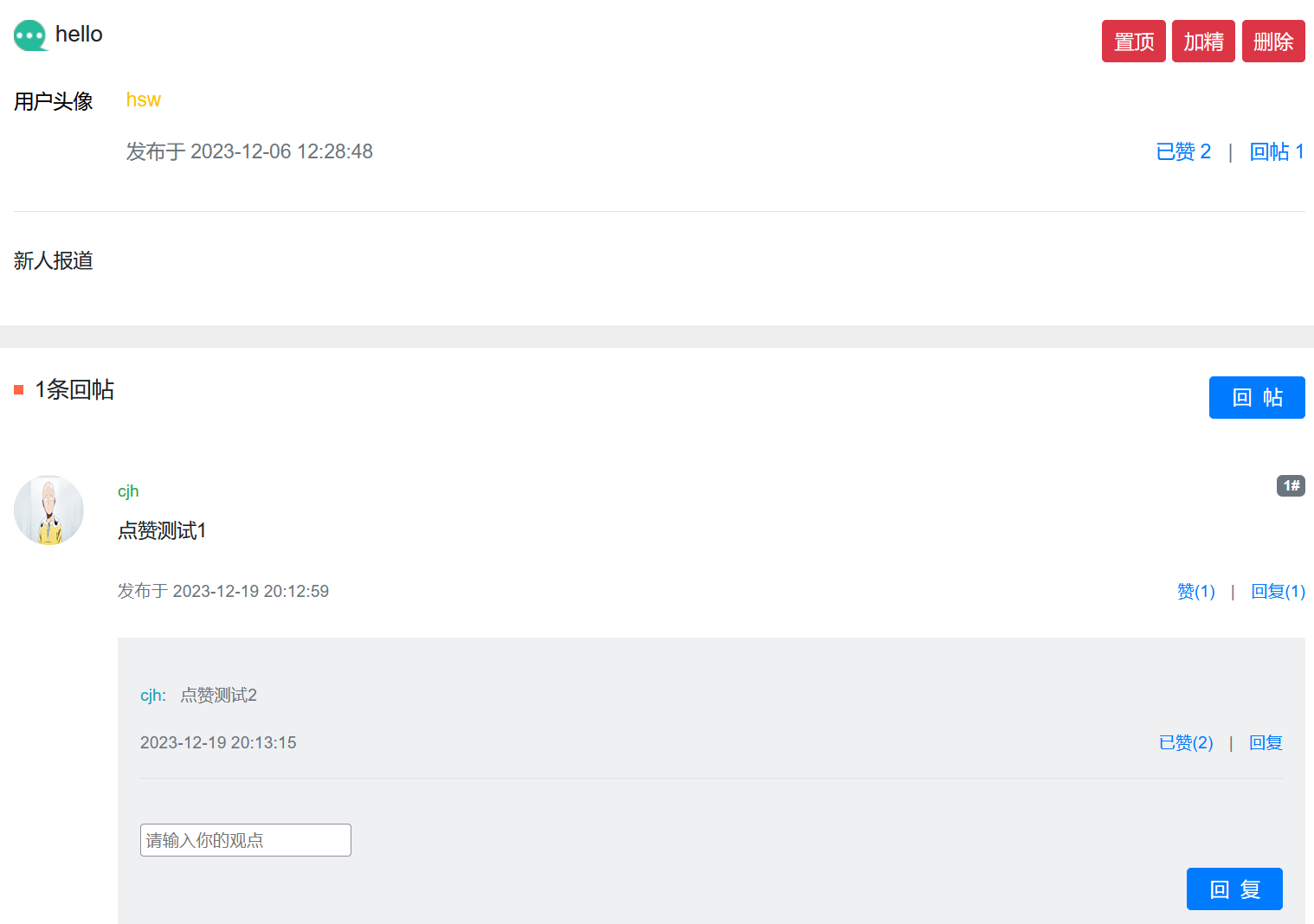
4.我收到的赞
- 重构点赞功能
- 以用户为key,记录点赞数量
- increment(key),decrement(key)
- 开发个人主页
- 以用户为key,查询点赞数量
(1)在RedisKeyUtil中增加方法,得到某个用户的赞
//某个用户的赞 public static String getUserLikeKey(int userId){ return PREFIX_ENTITY_LIKE+SPLIT+userId; }
(2)重构service层like()方法:需要记录点赞数量,在原先点赞的基础上加业务逻辑
在点赞方法中,获取被点赞帖子的用户id,增加点赞数量
public void like(int userId,int entityType,int entityId,int entityUserId){ String entityLikeKey= RedisKeyUtil.getEntityLikeKey(entityType, entityId);//实体点赞Key String userLikeKey=RedisKeyUtil.getUserLikeKey(entityUserId);//用户点赞Key boolean isMember=redisTemplate.opsForSet().isMember(entityLikeKey,userId); if(isMember){//第二次点赞:取消点赞 redisTemplate.opsForSet().remove(entityLikeKey,userId); //给该帖子的发出者减少点赞数量 redisTemplate.opsForValue().decrement(userLikeKey); }else{//第一次点赞:添加点赞 redisTemplate.opsForSet().add(entityLikeKey,userId); //给该帖子的发出者增加点赞数量 redisTemplate.opsForValue().increment(userLikeKey); } }
因为需要两次更新操作,这里改进成:redis编程事务
- 使用MULTI开启一个事务
- 在开启事务的时候,每次操作的命令将会被插入到一个队列中,同时这个命令并不会被真的执行
- EXEC命令进行提交事务
可以将 Redis 中的事务理解为:Redis 事务提供了一种将多个命令请求打包的功能。然后,再按顺序执行打包的所有命令,并且不会被中途打断。
Redis 事务实际开发中使用的非常少,功能比较鸡肋,不要将其和我们平时理解的关系型数据库的事务混淆了。
除了不满足原子性和持久性之外,事务中的每条命令都会与 Redis 服务器进行网络交互,这是比较浪费资源的行为。明明一次批量执行多个命令就可以了,这种操作实在是看不懂。
因此,Redis 事务是不建议在日常开发中使用的。
//点赞 public void like(int userId,int entityType,int entityId,int entityUserId){ redisTemplate.execute(new SessionCallback() { @Override public Object execute(RedisOperations operations) throws DataAccessException { String entityLikeKey= RedisKeyUtil.getEntityLikeKey(entityType, entityId);//实体点赞Key String userLikeKey=RedisKeyUtil.getUserLikeKey(entityUserId);//用户点赞Key boolean isMember=redisTemplate.opsForSet().isMember(entityLikeKey,userId); // 启用事务 operations.multi(); if(isMember){//第二次点赞:取消点赞 operations.opsForSet().remove(entityLikeKey,userId); //给该帖子的发出者减少点赞数量 operations.opsForValue().decrement(userLikeKey); }else{//第一次点赞:添加点赞 operations.opsForSet().add(entityLikeKey,userId); //给该帖子的发出者增加点赞数量 operations.opsForValue().increment(userLikeKey); } return operations.exec(); } }); }
添加一个查询用户所得赞的业务
//查询某个用户获得的赞 public int findUserLikeCount(int userId){ String userLikeKey=RedisKeyUtil.getUserLikeKey(userId); Integer count = (Integer) redisTemplate.opsForValue().get(userLikeKey); return count == null ? 0 : count.intValue(); }
修改LikeController中的like()
//增加一个参数: 实体发出者id likeService.like(user.getId(),entityType,entityId,entityUserId);
discuss-detail页面
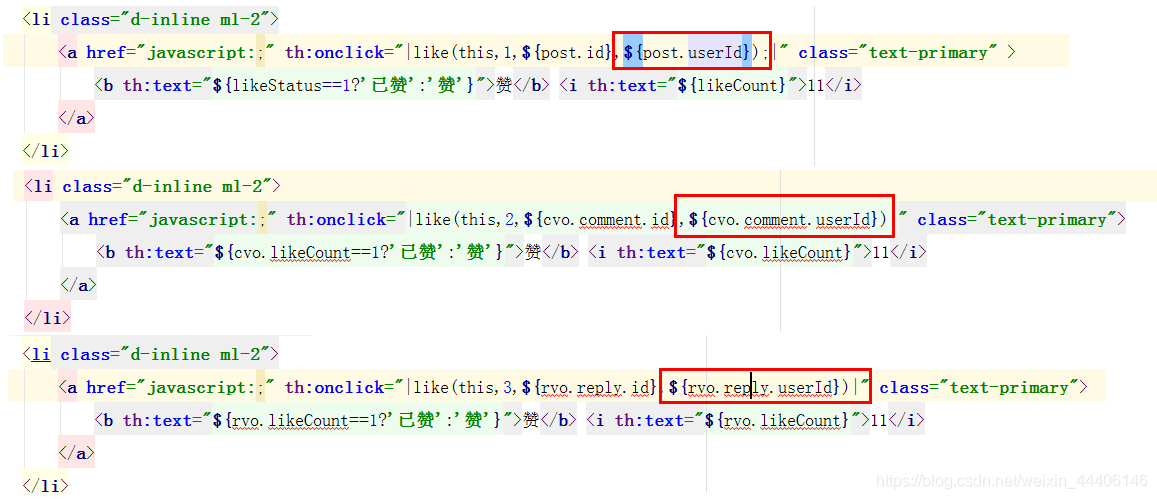
修改discuss.js中like方法
function like(btn, entityType, entityId,entityUserId) { $.post( CONTEXT_PATH + "/like", {"entityType":entityType,"entityId":entityId,"entityUserId":entityUserId}, function(data) { data = $.parseJSON(data); if(data.code == 0) { $(btn).children("i").text(data.likeCount); $(btn).children("b").text(data.likeStatus==1?'已赞':"赞"); } else { alert(data.msg); } } ); }
(3)开发个人主页
在UserController加方法
//个人主页 @RequestMapping(path = "/profile/{userId}",method = RequestMethod.GET) public String getProfilePage(@PathVariable("userId")int userId, Model model){ User user=userService.findUserById(userId); if(user==null){ throw new RuntimeException("该用户不存在"); } model.addAttribute("user",user); int likeCount=likeService.findUserLikeCount(userId); model.addAttribute("likeCount",likeCount); return "/site/profile"; }
修改index.html中个人主页的链接
<div class="dropdown-menu" aria-labelledby="navbarDropdown"> <a class="dropdown-item text-center" th:href="@{|/user/profile/${loginUser.id}|}">个人主页</a> <a class="dropdown-item text-center" th:href="@{/user/setting}">账号设置</a> <a class="dropdown-item text-center" th:href="@{/logout}">退出登录</a> <div class="dropdown-divider"></div> <span class="dropdown-item text-center text-secondary" th:utext="${loginUser.username}">nowcoder</span> </div>
用户头像也需要加链接:
<a th:href="@{|/user/profile/@{map.user.id}|}"> <img th:src="${map.user.headerUrl}" class="mr-4 rounded-circle" alt="用户头像" style="width:50px;height:50px;"> </a>
处理profile.html


5.关注、取消关注
- 需求
- 开发关注、取消关注功能。
- 统计用户的关注数、粉丝数。
- 关注
- 若A关注了B,则A是B的Follower(粉丝),B是A的Followee(目标)。
- 关注的目标可以是用户、帖子、题目等,在实现时将这些目标抽象为实体。
(1)修改RedisKeyUtil
添加两个方法
public class RedisKeyUtil { //key的分隔符 private static final String SPLIT = ":"; //点赞的前缀 private static final String PREFIX_ENTITY_LIKE = "like:entity"; private static final String PREFIX_USER_LIKE = "like:user"; private static final String PREFIX_FOLLOWEE = "followee"; private static final String PREFIX_FOLLOWER = "follower"; // 某个实体的赞 // like:entity:entityType:entityId -> set(userId) public static String getEntityLikeKey(int entityType, int entityId) { return PREFIX_ENTITY_LIKE + SPLIT + entityType + SPLIT + entityId; } //某个用户的赞 public static String getUserLikeKey(int userId){ return PREFIX_USER_LIKE+SPLIT+userId; } // 某个用户关注的实体 //这里实体的可以为用户,帖子 等 // followee:userId:entityType -> zset(entityId,now) public static String getFolloweeKey(int userId, int entityType) { return PREFIX_FOLLOWEE + SPLIT + userId + SPLIT + entityType; } // 某个实体拥有的粉丝 // follower:entityType:entityId -> zset(userId,now) public static String getFollowerKey(int entityType, int entityId) { return PREFIX_FOLLOWER + SPLIT + entityType + SPLIT + entityId; } }
(2)FollowService
@Service public class FollowService { @Autowired private RedisTemplate redisTemplate; //关注 public void follow(int userId,int entityType,int entityId){ redisTemplate.execute(new SessionCallback() { @Override public Object execute(RedisOperations operations) throws DataAccessException { String followeeKey= RedisKeyUtil.getFolloweeKey(userId,entityType);// 某个用户关注的实体 String followerKey=RedisKeyUtil.getFollowerKey(entityType,entityId);//某个实体的粉丝 operations.multi(); operations.opsForZSet().add(followeeKey,entityId,System.currentTimeMillis());//给user加了一个关注的实体entity operations.opsForZSet().add(followerKey,userId,System.currentTimeMillis());//给实体加了一个粉丝user return operations.exec(); } }); } //取消关注 public void unfollow(int userId,int entityType,int entityId){ redisTemplate.execute(new SessionCallback() { @Override public Object execute(RedisOperations operations) throws DataAccessException { String followeeKey= RedisKeyUtil.getFolloweeKey(userId,entityType);// 某个用户关注的实体 String followerKey=RedisKeyUtil.getFollowerKey(entityType,entityId);//某个实体的粉丝 operations.multi(); operations.opsForZSet().remove(followeeKey,entityId);//给user减少了一个关注的实体entity operations.opsForZSet().remove(followerKey,userId);//给实体减少了一个粉丝user return operations.exec(); } }); } //查询关注的实体的数量 public long findFolloweeCount(int userId, int entityType) { String followeeKey = RedisKeyUtil.getFolloweeKey(userId, entityType); return redisTemplate.opsForZSet().zCard(followeeKey); } //查询实体的粉丝数量 public long findFollowerCount(int entityType,int entityId) { String followerKey = RedisKeyUtil.getFollowerKey(entityType, entityId); return redisTemplate.opsForZSet().zCard(followerKey); } //查询当前用户是否已经关注该实体 public boolean hasFollowed(int userId,int entityType,int entityId){ String followeeKey= RedisKeyUtil.getFolloweeKey(userId,entityType); return redisTemplate.opsForZSet().score(followeeKey,entityId)!=null;//时间是否存在 } }
(3)FollowController
@Controller public class FollowController { @Autowired private FollowService followService; @Autowired private HostHolder hostHolder; @RequestMapping(path = "/follow",method = RequestMethod.POST) @ResponseBody public String follow(int entityType,int entityId){ User user=hostHolder.getUser(); followService.follow(user.getId(),entityType,entityId);//用户点关注 return CommunityUtil.getJSONString(0,"已关注!"); } @RequestMapping(path = "/unfollow",method = RequestMethod.POST) @ResponseBody public String unfollow(int entityType,int entityId){ User user=hostHolder.getUser(); followService.unfollow(user.getId(),entityType,entityId);//用户点关注 return CommunityUtil.getJSONString(0,"已取消关注!"); } }
(4)UserController中加逻辑
//个人主页 @RequestMapping(path = "/profile/{userId}",method = RequestMethod.GET) public String getProfilePage(@PathVariable("userId")int userId, Model model){ User user=userService.findUserById(userId); if(user==null){ throw new RuntimeException("该用户不存在"); } model.addAttribute("user",user); int likeCount=likeService.findUserLikeCount(userId); model.addAttribute("likeCount",likeCount); // 关注数量 long followeeCount = followService.findFolloweeCount(userId, ENTITY_TYPE_USER);//关注的实体是人 model.addAttribute("followeeCount", followeeCount); // 粉丝数量 long followerCount = followService.findFollowerCount(ENTITY_TYPE_USER, userId); model.addAttribute("followerCount", followerCount); // 是否已关注:当前用户对实体(用户)是否已关注 boolean hasFollowed = false; if (hostHolder.getUser() != null) { hasFollowed = followService.hasFollowed(hostHolder.getUser().getId(), ENTITY_TYPE_USER, userId); } model.addAttribute("hasFollowed", hasFollowed); return "/site/profile"; }
(5)修改profille.html
<div class="media mt-5"> <img th:src="${user.headerUrl}" class="align-self-start mr-4 rounded-circle" alt="用户头像" style="width:50px;"> <div class="media-body"> <h5 class="mt-0 text-warning"> <span th:utext="${user.username}">nowcoder</span> <input type="hidden" id="entityId" th:value="${user.id}"> <button type="button" th:class="|btn ${hasFollowed?'btn-secondary':'btn-info'} btn-sm float-right mr-5 follow-btn|" th:text="${hasFollowed?'已关注':'关注TA'}" th:if="${loginUser!=null&&loginUser.id!=user.id}">关注TA</button> </h5> <div class="text-muted mt-3"> <span>注册于 <i class="text-muted" th:text="${#dates.format(user.createTime,'yyyy-MM-dd HH:mm:ss')}">2015-06-12 15:20:12</i></span> </div> <div class="text-muted mt-3 mb-5"> <span>关注了 <a class="text-primary" href="followee.html" th:text="${followeeCount}">5</a> 人</span> <span class="ml-4">关注者 <a class="text-primary" href="follower.html" th:text="${followerCount}">123</a> 人</span> <span class="ml-4">获得了 <i class="text-danger" th:text="${likeCount}">87</i> 个赞</span> </div> </div> </div>
修改profile.js
$(function(){ $(".follow-btn").click(follow); }); function follow() { var btn = this; if($(btn).hasClass("btn-info")) { // 关注TA $.post( CONTEXT_PATH + "/follow", {"entityType":3,"entityId":$(btn).prev().val()}, function(data) { data = $.parseJSON(data); if(data.code == 0) { window.location.reload(); } else { alert(data.msg); } } ); // $(btn).text("已关注").removeClass("btn-info").addClass("btn-secondary"); } else { // 取消关注 $.post( CONTEXT_PATH + "/unfollow", {"entityType":3,"entityId":$(btn).prev().val()}, function(data) { data = $.parseJSON(data); if(data.code == 0) { window.location.reload(); } else { alert(data.msg); } } ); //$(btn).text("关注TA").removeClass("btn-secondary").addClass("btn-info"); } }
进入首页
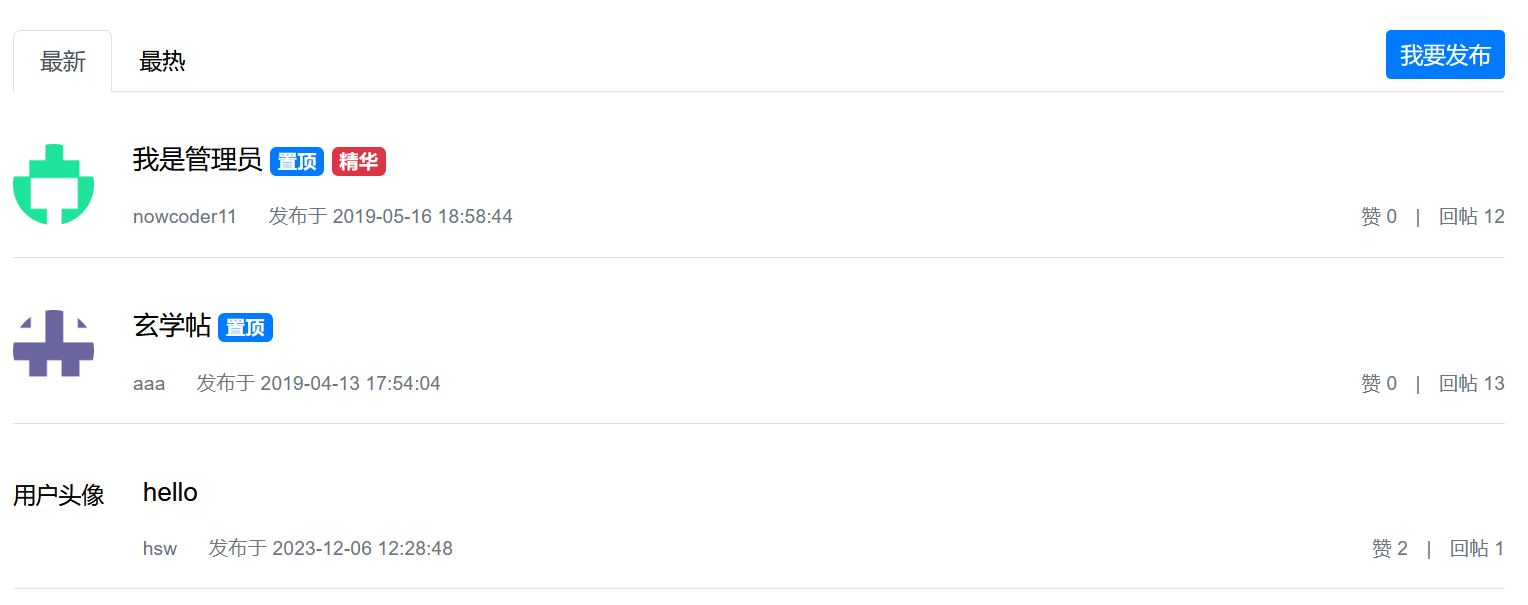
点击用户头像,进入用户个人主页,点击【关注TA】

aaa用户的【关注者加1】
6.关注列表、粉丝列表
- 业务层
- 查询某个用户关注的人,支持分页。【关注了x人】
- 查询某个用户的粉丝,支持分页。【关注者x人】
- 表现层
- 处理“查询关注的人”、“查询粉丝”请求。
- 编写“查询关注的人”、“查询粉丝”模板。
(1)FollowService添加方法
//查询某用户关注的人 //分页 public List<Map<String,Object>> findFollowees(int userId,int offset,int limit){ String followeeKey=RedisKeyUtil.getFolloweeKey(userId,ENTITY_TYPE_USER); Set<Integer> targetIds=redisTemplate.opsForZSet().reverseRange(followeeKey,offset,offset+limit-1);//从高到低 if(targetIds==null){ return null; } List<Map<String,Object>> list=new ArrayList<>(); for(Integer targetId:targetIds){ Map<String,Object> map=new HashMap<>(); User user = userService.findUserById(targetId); map.put("user", user); Double score = redisTemplate.opsForZSet().score(followeeKey, targetId); map.put("followTime", new Date(score.longValue())); list.add(map); } return list; } //查询某用户的粉丝 public List<Map<String,Object>> findFollowers(int userId,int offset,int limit){ String followerKey=RedisKeyUtil.getFollowerKey(ENTITY_TYPE_USER,userId); Set<Integer> targetIds=redisTemplate.opsForZSet().reverseRange(followerKey, offset, offset + limit - 1); if (targetIds == null) { return null; } List<Map<String, Object>> list = new ArrayList<>(); for (Integer targetId : targetIds) { Map<String, Object> map = new HashMap<>(); User user = userService.findUserById(targetId); map.put("user", user); Double score = redisTemplate.opsForZSet().score(followerKey, targetId); map.put("followTime", new Date(score.longValue())); list.add(map); } return list; }
(2)FollowController
//找关注的人 @RequestMapping(path = "/followees/{userId}",method = RequestMethod.GET) public String getFollowees(@PathVariable("userId")int userId, Page page, Model model){ User user = userService.findUserById(userId); if (user == null) { throw new RuntimeException("该用户不存在!"); } model.addAttribute("user", user); page.setLimit(5); page.setPath("/followees/" + userId); page.setRows((int) followService.findFolloweeCount(userId, ENTITY_TYPE_USER)); //关注的人列表 List<Map<String, Object>> userList = followService.findFollowees(userId, page.getOffset(), page.getLimit()); if (userList != null) { for (Map<String, Object> map : userList) { User u = (User) map.get("user"); map.put("hasFollowed", hasFollowed(u.getId()));//是否已关注 } } model.addAttribute("users", userList); return "/site/followee"; } //找粉丝 @RequestMapping(path = "/followers/{userId}",method = RequestMethod.GET) public String getFollowers(@PathVariable("userId") int userId, Page page, Model model){ User user=userService.findUserById(userId); if(user==null){ throw new RuntimeException("该用户不存在!"); } model.addAttribute("user",user); page.setLimit(5); page.setPath("/followers/" + userId); page.setRows((int) followService.findFollowerCount(ENTITY_TYPE_USER, userId)); //粉丝列表(某userId用户的粉丝) List<Map<String,Object>> userList=followService.findFollowers(userId,page.getOffset(),page.getLimit()); if (userList != null) { for (Map<String, Object> map : userList) { User u = (User) map.get("user"); map.put("hasFollowed", hasFollowed(u.getId())); } } model.addAttribute("users",userList); return "/site/follower"; } private boolean hasFollowed(int userId){//当前用户有没有关注userId用户 if(hostHolder.getUser()==null){ return false; } return followService.hasFollowed(hostHolder.getUser().getId(),ENTITY_TYPE_USER,userId); }
(3)修改profile.html
<div class="text-muted mt-3 mb-5"> <span>关注了 <a class="text-primary" th:href="@{|/followees/${user.id}|}" th:text="${followeeCount}">5</a> 人</span> <span class="ml-4">关注者 <a class="text-primary" th:href="@{|/followers/${user.id}|}" th:text="${followerCount}">123</a> 人</span> <span class="ml-4">获得了 <i class="text-danger" th:text="${likeCount}">87</i> 个赞</span> </div>
(4)增加follower.html、followee.html
<!-- 内容 --> <div class="main"> <div class="container"> <div class="position-relative"> <!-- 选项 --> <ul class="nav nav-tabs mb-3"> <li class="nav-item"> <a class="nav-link position-relative active" th:href="@{|/followees/${user.id}|}"> <i class="text-info" th:utext="${user.username}">Nowcoder</i> 关注的人 </a> </li> <li class="nav-item"> <a class="nav-link position-relative" th:href="@{|/followers/${user.id}|}"> 关注 <i class="text-info" th:utext="${user.username}">Nowcoder</i> 的人 </a> </li> </ul> <a th:href="@{|/user/profile/${user.id}|}" class="text-muted position-absolute rt-0">返回个人主页></a> </div> <!-- 关注列表 --> <ul class="list-unstyled"> <li class="media pb-3 pt-3 mb-3 border-bottom position-relative" th:each="map:${users}"> <a th:href="@{|/user/profile/${map.user.id}|}"> <img th:src="${map.user.headerUrl}" class="mr-4 rounded-circle user-header" alt="用户头像" > </a> <div class="media-body"> <h6 class="mt-0 mb-3"> <span class="text-success" th:utext="${map.user.username}">落基山脉下的闲人</span> <span class="float-right text-muted font-size-12"> 关注于 <i th:text="${#dates.format(map.followTime,'yyyy-MM-dd HH:mm:ss')}">2019-04-28 14:13:25</i> </span> </h6> <div> <input type="hidden" id="entityId" th:value="${map.user.id}"> <button type="button" th:class="|btn ${map.hasFollowed?'btn-secondary':'btn-info'} btn-sm float-right follow-btn|" th:if="${loginUser!=null && loginUser.id!=map.user.id}" th:text="${map.hasFollowed?'已关注':'关注TA'}">关注TA</button> </div> </div> </li> </ul> <!-- 分页 --> <nav class="mt-5" th:replace="index::pagination"> <ul class="pagination justify-content-center"> <li class="page-item"><a class="page-link" href="#">首页</a></li> <li class="page-item disabled"><a class="page-link" href="#">上一页</a></li> <li class="page-item active"><a class="page-link" href="#">1</a></li> <li class="page-item"><a class="page-link" href="#">2</a></li> <li class="page-item"><a class="page-link" href="#">3</a></li> <li class="page-item"><a class="page-link" href="#">4</a></li> <li class="page-item"><a class="page-link" href="#">5</a></li> <li class="page-item"><a class="page-link" href="#">下一页</a></li> <li class="page-item"><a class="page-link" href="#">末页</a></li> </ul> </nav> </div> </div>
<!-- 内容 --> <div class="main"> <div class="container"> <div class="position-relative"> <!-- 选项 --> <ul class="nav nav-tabs mb-3"> <li class="nav-item"> <a class="nav-link position-relative" th:href="@{|/followees/${user.id}|}"> <i class="text-info" th:utext="${user.username}">Nowcoder</i> 关注的人 </a> </li> <li class="nav-item"> <a class="nav-link position-relative active" th:href="@{|/followers/${user.id}|}"> 关注 <i class="text-info" th:utext="${user.username}">Nowcoder</i> 的人 </a> </li> </ul> <a th:href="@{|/user/profile/${user.id}|}" class="text-muted position-absolute rt-0">返回个人主页></a> </div> <!-- 粉丝列表 --> <ul class="list-unstyled"> <li class="media pb-3 pt-3 mb-3 border-bottom position-relative" th:each="map:${users}"> <a th:href="@{|/user/profile/${map.user.id}|}"> <img th:src="${map.user.headerUrl}" class="mr-4 rounded-circle user-header" alt="用户头像" > </a> <div class="media-body"> <h6 class="mt-0 mb-3"> <span class="text-success" th:utext="${map.user.username}">落基山脉下的闲人</span> <span class="float-right text-muted font-size-12"> 关注于 <i th:text="${#dates.format(map.followTime,'yyyy-MM-dd HH:mm:ss')}">2019-04-28 14:13:25</i> </span> </h6> <div> <input type="hidden" id="entityId" th:value="${map.user.id}"> <button type="button" th:class="|btn ${map.hasFollowed?'btn-secondary':'btn-info'} btn-sm float-right follow-btn|" th:if="${loginUser!=null && loginUser.id!=map.user.id}" th:text="${map.hasFollowed?'已关注':'关注TA'}">关注TA</button> </div> </div> </li> </ul> <!-- 分页 --> <nav class="mt-5" th:replace="index::pagination"> <ul class="pagination justify-content-center"> <li class="page-item"><a class="page-link" href="#">首页</a></li> <li class="page-item disabled"><a class="page-link" href="#">上一页</a></li> <li class="page-item active"><a class="page-link" href="#">1</a></li> <li class="page-item"><a class="page-link" href="#">2</a></li> <li class="page-item"><a class="page-link" href="#">3</a></li> <li class="page-item"><a class="page-link" href="#">4</a></li> <li class="page-item"><a class="page-link" href="#">5</a></li> <li class="page-item"><a class="page-link" href="#">下一页</a></li> <li class="page-item"><a class="page-link" href="#">末页</a></li> </ul> </nav> </div> </div>

7.优化登录模块
-
使用Redis存储验证码
- 验证码需要频繁的访问与刷新,对性能要求较高。
- 验证码不需永久保存,通常在很短的时间后就会失效。
- 分布式部署时,存在Session共享的问题。
-
使用Redis存储登录凭证
- 处理每次请求时,都要查询用户的登录凭证,访问的频率非常高。
-
使用Redis缓存用户信息
- 处理每次请求时,都要根据凭证查询用户信息,访问的频率非常高。
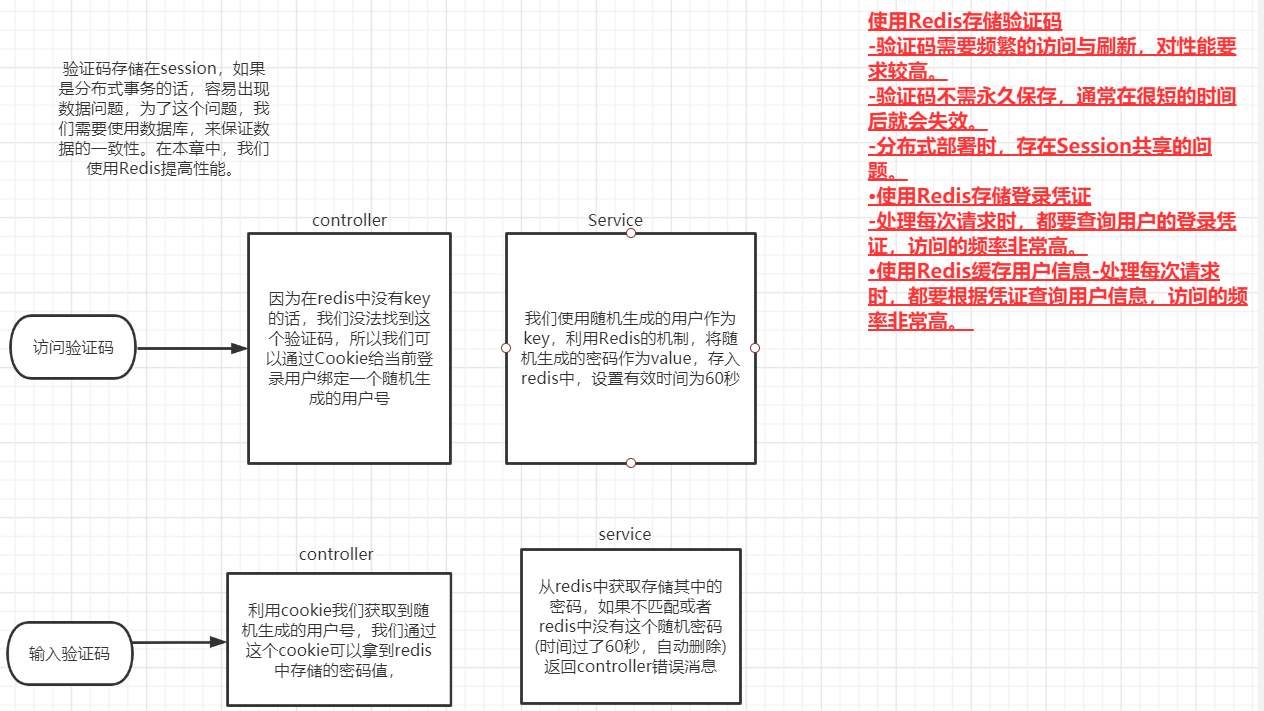
使用Redis存储验证码
(1)修改RedisKeyUtil,新增验证码对应的Key
public class RedisKeyUtil { ...//点赞的前缀private static final String PREFIX_KAPTCHA = "kaptcha"; private static final String PREFIX_TICKET = "ticket"; private static final String PREFIX_USER = "user"; ...//登录验证码 public static String getKaptchaKey(String owner) { return PREFIX_KAPTCHA + SPLIT + owner; } //登录凭证 public static String getTicketKey(String ticket) { return PREFIX_TICKET + SPLIT + ticket; } //用户 public static String getUserKey(int userId) { return PREFIX_USER + SPLIT + userId; } }
(2)优化验证码功能,以凭证为key,把验证码存入Redis
从redis中获取验证码,首先当客户端获取验证码时,先随机生成一个值,这个值作为是客户的登录凭证,我们将这个凭证设置时间为60秒,到时间自动删除。
修改LoginController中getKaptcha()方法
@RequestMapping(path = "/kaptcha",method = RequestMethod.GET) public void getKaptcha(HttpServletResponse response, HttpSession session){ //生成验证码 String text=kaptchaProducer.createText(); BufferedImage image=kaptchaProducer.createImage(text); //验证码存入session //session.setAttribute("kaptcha",text); //存入redis String kaptchaOwner= CommunityUtil.generateUUID();//标识是谁在登陆 Cookie cookie=new Cookie("kaptchaOwner",kaptchaOwner); cookie.setMaxAge(60); cookie.setPath(contextPath); response.addCookie(cookie); String rediskey= RedisKeyUtil.getKaptchaKey(kaptchaOwner); redisTemplate.opsForValue().set(rediskey,text,60, TimeUnit.SECONDS); //将图片输出给浏览器 try { OutputStream os= response.getOutputStream(); ImageIO.write(image,"png",os); } catch (IOException e) { logger.error("响应验证码失败:"+e.getMessage()); } }
修改login()方法,从Cookie中获取凭证,验证验证码
@RequestMapping(path = "/login",method = RequestMethod.POST) public String login(String username,String password,String code,boolean rememberme, Model model,/*HttpSession session*/@CookieValue("kaptchaOwner")String kaptchaOwner,HttpServletResponse response){ //检查验证码 //从session取 //String kaptcha=(String)session.getAttribute("kaptcha"); //从redis中取 String kaptcha=null; if(StringUtils.isNotBlank(kaptchaOwner)){ String redisKey=RedisKeyUtil.getKaptchaKey(kaptchaOwner); kaptcha= (String) redisTemplate.opsForValue().get(redisKey); } ... }
使用Redis存储登录凭证
登录凭证有就在redis取,没有就在数据库取
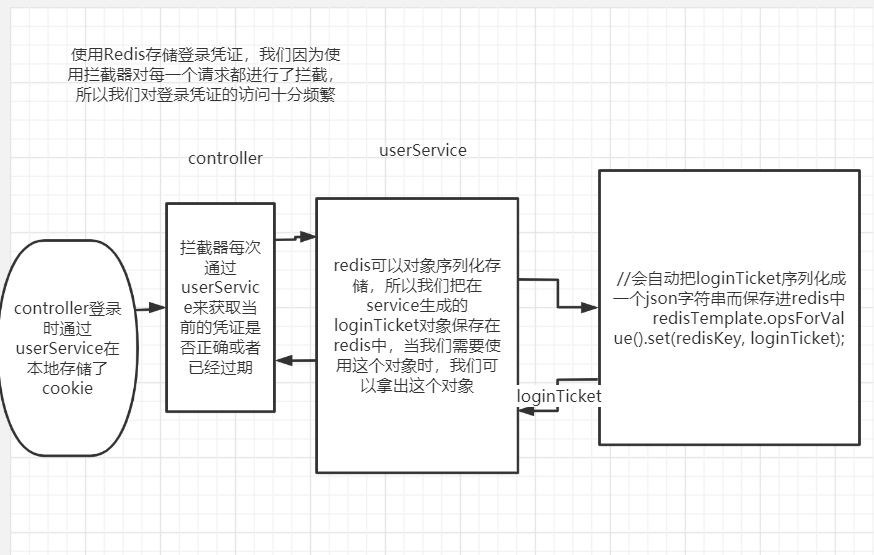
(1) 修改RedisKeyUtil,新增ticket对应的Key
(2) 原有的Dao层LoginTicketMapper可以不用了(加注解@Deprecated表示不推荐使用),用redis存登录凭证
@Mapper @Deprecated public interface LoginTicketMapper {...}
(3)修改存储登录凭证的逻辑
//5.登录逻辑 public Map<String,Object> login(String username,String password,int expiredSeconds){ ... //生成登陆凭证 LoginTicket loginTicket=new LoginTicket(); loginTicket.setUserId(user.getId()); loginTicket.setTicket(CommunityUtil.generateUUID());//凭证 loginTicket.setStatus(0); loginTicket.setExpired(new Date(System.currentTimeMillis()+expiredSeconds*1000)); //loginTicketMapper.insertLoginTicket(loginTicket); //登录凭证存入redis String ticketKey= RedisKeyUtil.getTicketKey(loginTicket.getTicket()); redisTemplate.opsForValue().set(ticketKey,loginTicket); map.put("ticket",loginTicket.getTicket()); return map; } //登录退出 public void logout(String ticket){ loginTicketMapper.updateStatus(ticket,1);//修改该凭证的登陆状态 //修改该凭证的登陆状态 String ticketKey= RedisKeyUtil.getTicketKey(ticket); LoginTicket loginTicket=(LoginTicket) redisTemplate.opsForValue().get(ticketKey); loginTicket.setStatus(1);//修改状态 redisTemplate.opsForValue().set(ticketKey,loginTicket); } //找到该登录凭证信息 public LoginTicket findLoginTicket(String ticket){ //return loginTicketMapper.selectByTicket(ticket); String ticketKey= RedisKeyUtil.getTicketKey(ticket); LoginTicket loginTicket=(LoginTicket) redisTemplate.opsForValue().get(ticketKey); return loginTicket; }
使用Redis缓存用户信息
查询用户的时候先从Redis中取,没有先从数据库中取然后存到redis中。用户状态变化时直接删除Redis中的数据。
(1)RedisKeyUtil中增加user的key
(2)在userSerVice中封装三个方法
//在redis缓存用户信息 // 1.优先从缓存中取值 private User getCache(int userId) { String redisKey = RedisKeyUtil.getUserKey(userId); return (User) redisTemplate.opsForValue().get(redisKey); } // 2.取不到时初始化缓存数据 private User initCache(int userId) { User user = userMapper.selectById(userId); String redisKey = RedisKeyUtil.getUserKey(userId); redisTemplate.opsForValue().set(redisKey, user, 3600, TimeUnit.SECONDS); return user; } // 3.数据变更时清除缓存数据 private void clearCache(int userId) { String redisKey = RedisKeyUtil.getUserKey(userId); redisTemplate.delete(redisKey); }
(3)涉及到User查询(userMapper)的地方换成调用redis的这三个方法
public User findUserById(int id){ User user=getCache(id); if(user==null){ user=initCache(id);//缓存里没有则去数据库取 } return user; //return userMapper.selectById(id); } //账户设置:更新用户URL(上传头像后) public int updateHeader(int userId,String headerUrl){ int rows=userMapper.updateHeader(userId,headerUrl); clearCache(userId);//用户变更直接删除缓存 return rows; //return userMapper.updateHeader(userId,headerUrl); }



